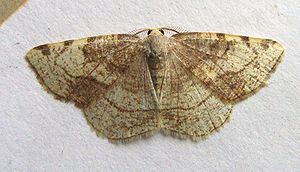Three-point poplar spanner
| Three-point poplar spanner | ||||||||||||
|---|---|---|---|---|---|---|---|---|---|---|---|---|

Three-spotted poplar moth ( Stegania trimaculata ), male |
||||||||||||
| Systematics | ||||||||||||
|
||||||||||||
| Scientific name | ||||||||||||
| Stegania trimaculata | ||||||||||||
| ( De Villers , 1789) |
The Dreifleck- Poplarspanner ( Stegania trimaculata ) also straw-yellow glossy-edge spanner is a butterfly ( moth ) from the family of the Spanner (Geometridae).
features
butterfly
The moth has a wingspan of 17 to 22 millimeters. The basic color of the wings is cream to light brown. The drawing is very variable in detail. As a rule, three brown spots on the front edge of the forewings and two brown transverse lines are characteristic. However, there are also specimens with almost extinguished transverse lines. The seam line typically shows a pointed to rounded bulge towards the apex. The wings can be dusted brown to varying degrees, and therefore more brown spots can be present. In some specimens, the wing veins emerge from the over-dusting. The hind wings have the same basic color as the forewings, but there is only one transverse line.
Caterpillar and pupa
The caterpillar can be green with a red-brown, interrupted topline, or it is brown with a light, interrupted topline. The doll is brown and has two diverging bristles on the cremaster .
distribution
The species is mainly found in North Africa and in Western Europe and Western Southern Europe (Iberian Peninsula, Italy). But it is missing in Southeastern Europe (Balkan Peninsula). There is only evidence from Slovenia and Dalmatia (Croatia). It seems to have come to Belgium and the Netherlands only in the last 20 years. Only one find is known from England . She only immigrated to Germany in the course of the 20th century. Today it can also be found in many other heat-favored areas of Germany. Finds as far as Brandenburg are reported in the northeast . The species is said to occur outside of Europe in Turkmenistan and Uzbekistan . These occurrences are not confirmed by Leraut (2009).
Occurrence
The species occurs mainly in river valleys and alluvial forests , where poplars grow, but also in the open landscape with poplar plantations. In Germany she prefers heat-favored areas. It rises up to 1,000 meters in the Alps , but in Germany it is limited to the plains and the flat hill country below 200 to 300 meters. The species is only distributed very locally and is not common.
Way of life
The three-spotted poplar moth forms two, partly overlapping generations, whose moths fly from May to June and from July to August. In higher elevations, the generations appear a little later. The moths were observed sucking nectar on linden blossoms. They fly at night and are attracted to artificial light sources. During the day they sit on poplar trunks or in the grass. They also fly occasionally during the day. The eggs are only laid on the leaves of different poplar species ( Populus ). The caterpillars can be found from June to August. Pupation takes place in a spun leaf, the pupa overwinters. The moths hatch in spring.
Danger
The species is classified as critically endangered in Bavaria (category 2), in Rhineland-Palatinate as endangered (category 3). In contrast, the authors of the work "The Butterflies of Baden-Württemberg" interpret the species as an area enlarger, which means that it is currently expanding its range to the north and northeast.
swell
Individual evidence
- ↑ a b Red Lists
- ↑ Leraut (2009: p. 64/5)
- ↑ Ebert et al. (2003: pp. 310-313)
- ↑ Walter Forster , Theodor A. Wohlfahrt : The butterflies of Central Europe. Volume 5: Spanner. (Geometridae). Franckh'sche Verlagshandlung, Stuttgart 1981, ISBN 3-440-04951-5 .
literature
- Günter Ebert (Ed.): The butterflies of Baden-Württemberg. Volume 9 (Spanner (Geometridae) 2nd part), Nachtfalter VII. Ulmer Verlag, Stuttgart 2003, ISBN 3-8001-3279-6 .
- Patrice Leraut: Moths of Europe. Volume II. Geometrid moths. NAP Editions, Verrières-le-Buisson 2009, ISBN 978-2-913688-09-4 .
- Patrice Leraut: Geometrid moths . In: Moths of Europe . 1st edition. Volume II. NAP Editions, 2009, ISBN 978-2-913688-09-4 (English).